Towaco Formation (NJ) - (Lower Jurassic) Olsen, P.E., 1980a[1] - Unit is covered by surficial deposits but identified through well logs (Stanford, 1991). Elsewhere unit is reddish-brown to brownish-purple, buff, olive-tan, or light-olive-gray, fine- to medium-grained, micaceous sandstone, siltstone, and silty mudstone in fining-upward sequences 3 to 10 feet thick. Unit consists of at least eight sequences of gray, greenish-gray, or brownish-gray, fine-grained sandstone, siltstone, and calcareous siltstone, and black microlaminated calcareous siltstone and mudstone with diagnostic pollen grains, dinosaur tracks and fish fossils. Irregular mudcracks, symmetrical ripple marks present. Sandstone is commonly hummocky and trough cross-laminated and siltstone is commonly planar-laminated or bioturbated and indistinctly laminated to massive. Several inches of unit have been thermally metamorphosed along contact with Hook Mountain Basalt. Maximum thickness is about 1,250 ft.
All footprints here are from the early Jurassic Period (195 mya) from the Towaco Formation. The slabs here are fine red-sandstones which were deposited during the formation of the Newark rift basin.
Typical ichnotaxon list:
Ameghinichnus n. sp.(advanced synapsid, possibly trithelodontid),
Anchisauripus tuberosus (small to medium sized theropod dinosaur),
Anomoepus scambus (ornithischian dinosaur),
Atreipus sp. (ornithischian dinosaur),
Batrachopus deweyii (crocodylomorph),
Grallator parallelus (small theropod dinosaur),
Eubrontes giganteus (large theropod dinosaur),
Rhynchosauroides sp. (lepidosauromorphs), and others.
(advanced synapsid, possibly trithelodontid)


(small to medium sized theropod dinosaur)

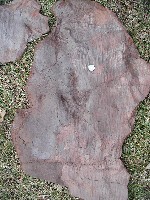
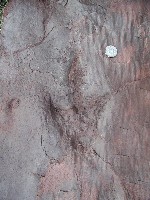
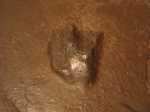
(ornithischian dinosaur)

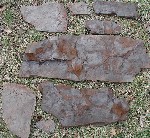
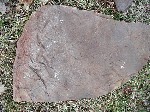


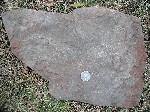
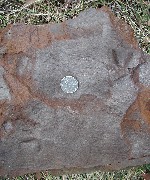
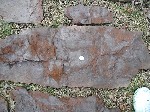
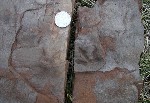
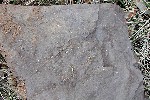
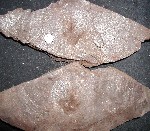
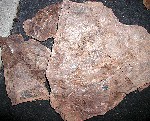
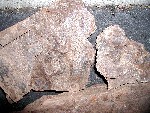
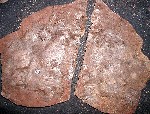
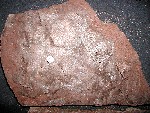
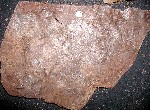
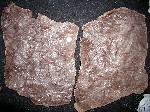
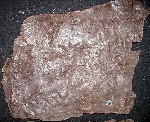
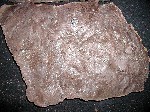
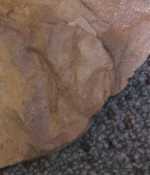
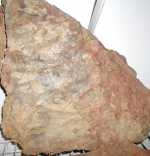
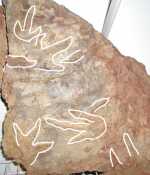
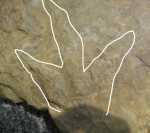
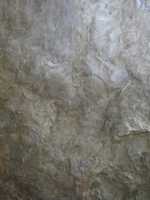
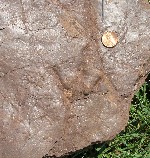
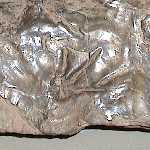
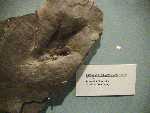
SECOND ROW: 7-9) Slabs with 1-2" prints. 10) A slab with one print. 11-12) Slabs with a lot of prints.
THIRD ROW: 13-18) Slabs with a whole lot of prints.
FOURTH ROW: 19) A 1 3/4" print. 20&21) A slab without and with outlined prints. The largest print is 3 1/2". 22) A 1 1/2" print. 23) A faint 3" print. 24) Small but clear print.
FIFTH ROW: 25) Anomoepus from Morris Museum. 26) Anomoepus from Morris Museum.
(ornithischian dinosaur)

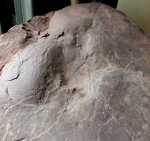
(crocodylomorph)

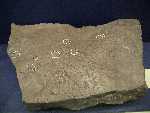
(large theropod dinosaur)

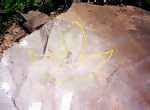
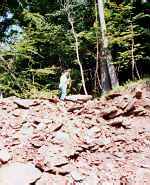
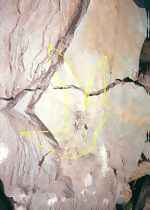
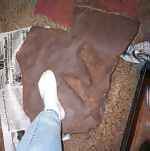
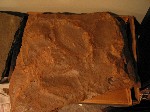
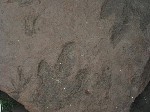
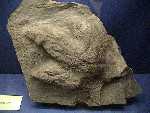
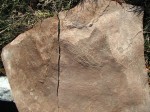
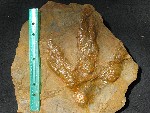
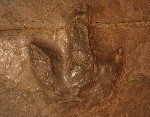
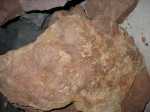
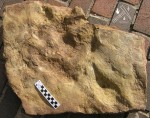
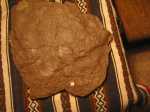
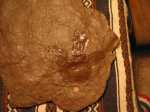
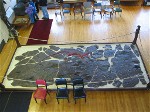



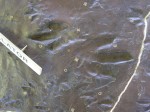
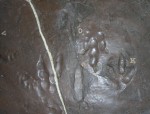
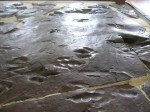
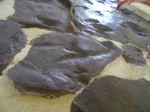
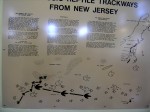
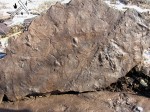

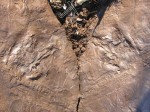
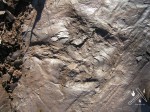
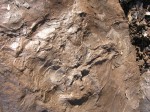
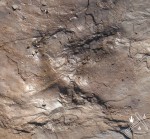
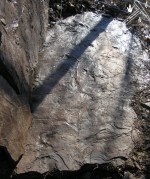
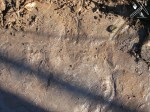
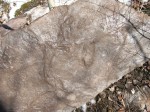

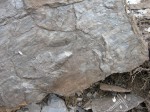
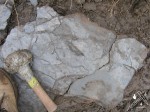
SECOND ROW: 7) 10" Eubrontes print from the Morris Museum. 8-12) A 13" Eubrontes giganteus on ripple rock. My best find. Note, print #12 is the ghost print or the back side of the imprint slab.
THIRD ROW: 13) Grand's Eubrontes (or possibly Anomoepus scambus or Anchisauripus). 14) John's Eubrontes (or possibly Anomoepus scambus or Anchisauripus). 15-17) John's Eubrontes. 18) Same as #17 but highlighted with water.
FOURTH ROW: 19-24) Eubrontes giganteus and Grallator tracks from the Vreeland Quarry. Photos from the Rutgers Geology Museum.
FIFTH ROW: 25-27) More photos from the Rutgers Geology Museum. Note the last photo has a tail impression. 27) A description of the site from the Rutgers Geology Museum. 28-30) John and Henry find a productive layer with a Eubrontes track.
SIXTH ROW: 31-34) More photos of the same layer. 35-36) The underprint or ghost print of the same Eubontes.
SEVENTH ROW: 37-39) A possible juvenile Eubrontes on the left and a grallator on the right.
4 prints in deep soft mud


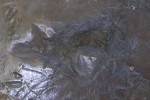



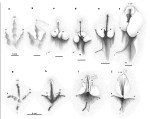
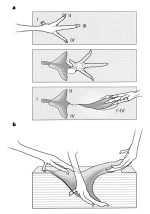
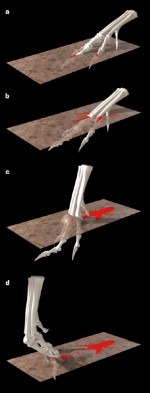
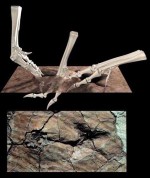
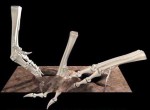
SECOND ROW: 7) The spectrum of theropod tracks preserved in the Triassic Fleming Fjord Formation of Greenland (a-f) is comparable to that produced by an extant bird (the helmeted guineafowl, Numida meleagris) (g-j). On firm substrates, tracks closely reflect plantar morphology (a, g). The feet sink progressively deeper as sediment hydration increases (b-f and h-j). As a result, digits II and IV begin to converge before the foot is withdrawn, thereby creating separate entry (II, IV) and exit (II', IV') furrows (c-e, h, i) or a single terminal exit (f, j). Unlike birds, however, Triassic theropods left a distinct metatarsal impression (M) in deeper tracks (d-f). Greenlandic footprints were drawn from separate trackways and represent different individuals as well as variant details, whereas the avian prints were made by the same bird. The track illustrated in b is partially obscured by an overprint of another track. Theropod tracks (a-f) are registered in the Geological Museum, University of Copenhagen, as MGUH VP 3386±3391.Stephen M. Gatesy, 1999[5] 8) Early, middle, and late phases in the formation of a footprint in deep mud. a, Dorsal and b, Lateral views. As the foot penetrates down and forward, the metatarsus becomes more vertical, leaving little or no impression at the rear of the track. The digits converge subsurface, emerging from the substrate (I'-IV') well in front of their points of entry (I-IV). Foot positions were reconstructed from video records of a single stride taken simultaneously in lateral and posterior views, and aligned with respect to the resulting track.Stephen M. Gatesy, 1999[5] 9) Three-dimensional computer reconstruction of theropod foot movements producing an elongate print in deep mud. Penetration through the substrate surface is shown in red. The hallux, which is not `reversed' as in modern birds, leaves a posteromedially oriented entry furrow (a, b) as the digit plunges down and forward. The ankle is not immediately lifted during the stance phase, and as a result a metatarsal impression is created (c), elongating the track posteriorly. All digits converge beneath the surface and emerge together from the anterior end of the track (d).Stephen M. Gatesy, 1999[5] 10) A three-dimensional computer reconstruction (top photo) showing a theropod foot moving right to left at three stages in creation of a deep track. And a photograph of a deep Greenlandic footprint (bottom photo). Stephen M. Gatesy, 1999[5] 11) The same photos but animated.
(small theropod dinosaur)


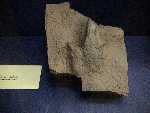
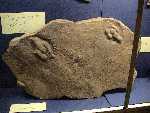

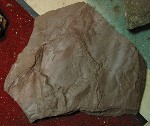
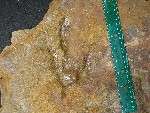
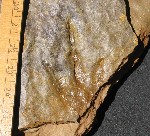
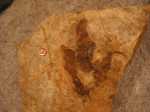
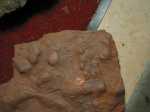
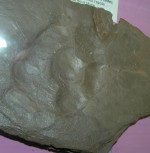
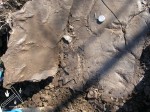
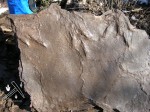
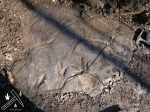
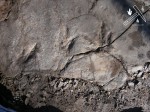
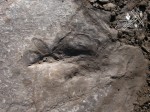
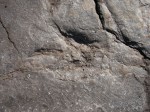
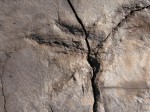
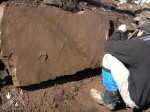
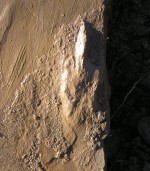
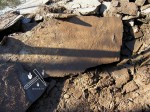

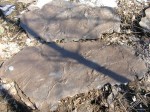

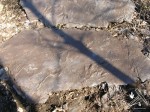
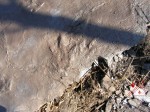
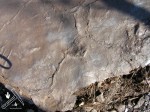
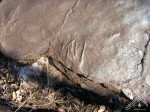
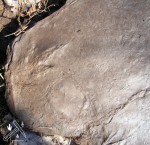
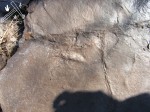
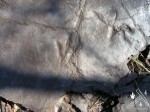
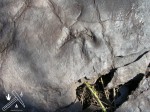



SECOND ROW: 6) John's Grallator. 7&8) Grand's Grallators. 9) John's Grallator. 10) John's slab with possible tracks but a Grallator above the penny.
THIRD ROW: 11) Photo from the Rutgers Geology Museum. 12-14) John and Henry find a productive layer with Grallator tracks.
FOURTH ROW: 15-18) More photos of the same layer.
FIFTH ROW: 19-22) We lift two huge flat slabs about 7' by 4' by 6" thick and find these three tracks. 23) John and Henry continue to dig alone the productive layer.
SIXTH ROW: 24-28) Close-ups of the same slab. Note the strange marks in photos number 28.
SEVENTH ROW: 29-32) More close-ups.
EIGHTH ROW: 33-35) A possible juvenile Eubrontes on the left and a grallator on the right.
(lepidosauromorphs)


(large theropod dinosaur)
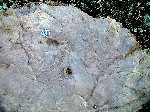
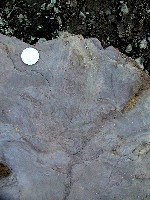
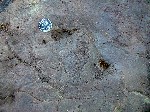
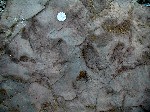
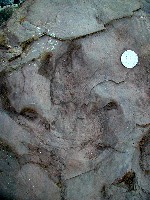
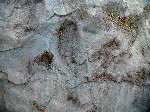
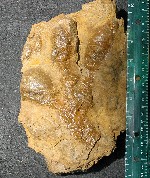
SECOND ROW: 7) Grand's unknown print.
(medium size creature)
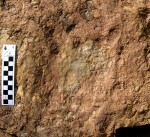
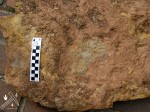
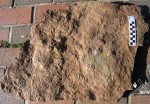
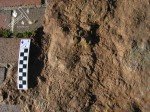
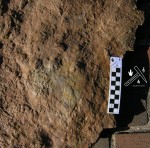
(medium theropod dinosaur)
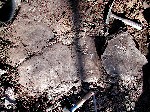
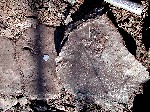

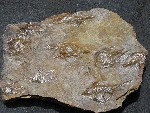
(small creature)
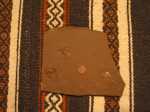
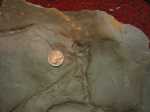
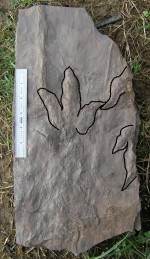
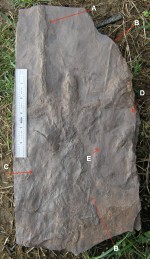
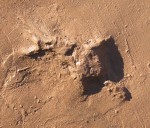
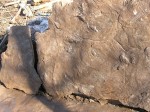
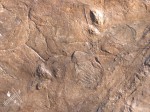
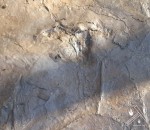
C - possible insect trails. D - possible skin marks. E - three parallel traces, unknown origin. 5) One odd print on a large flat slab.
SECOND ROW: 6-8) Unknown prints, one seems to have a prominent thumb.
(ripples, desiccation cracks, etc)
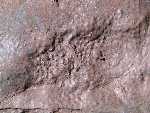
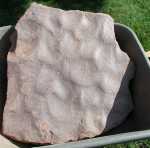
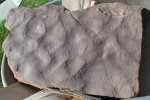
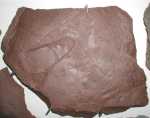
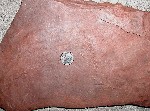
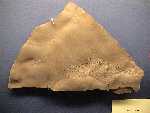
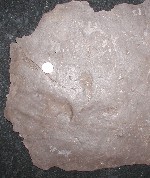
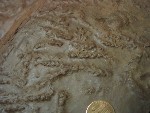
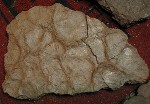
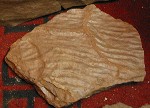
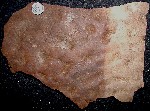
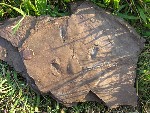

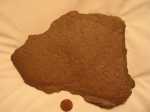
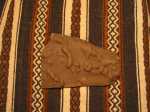
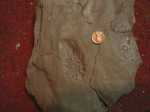
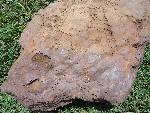
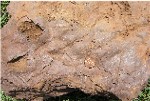

SECOND ROW: 7) A ghost print (undertrack). 8) John's insect tracks. 9) John's desiccation cracks. 10) John's ripples with desiccation cracks. 11) A slab with poorly preserved prints on ripple rock. 12) A ghost print (undertrack).
THIRD ROW: 13) Possible insect tracks. 14) John's slab with rain-drop impressions. 15) John's slab with mud impressions or coprolites. 16) John's slab with possible skin impressions. 17&18) Henry's slab with possible skin impressions.
FOURTH ROW: 19) Possible scratch marks or claw marks.